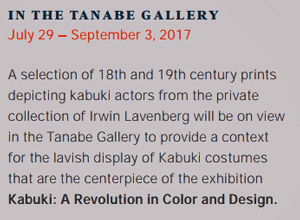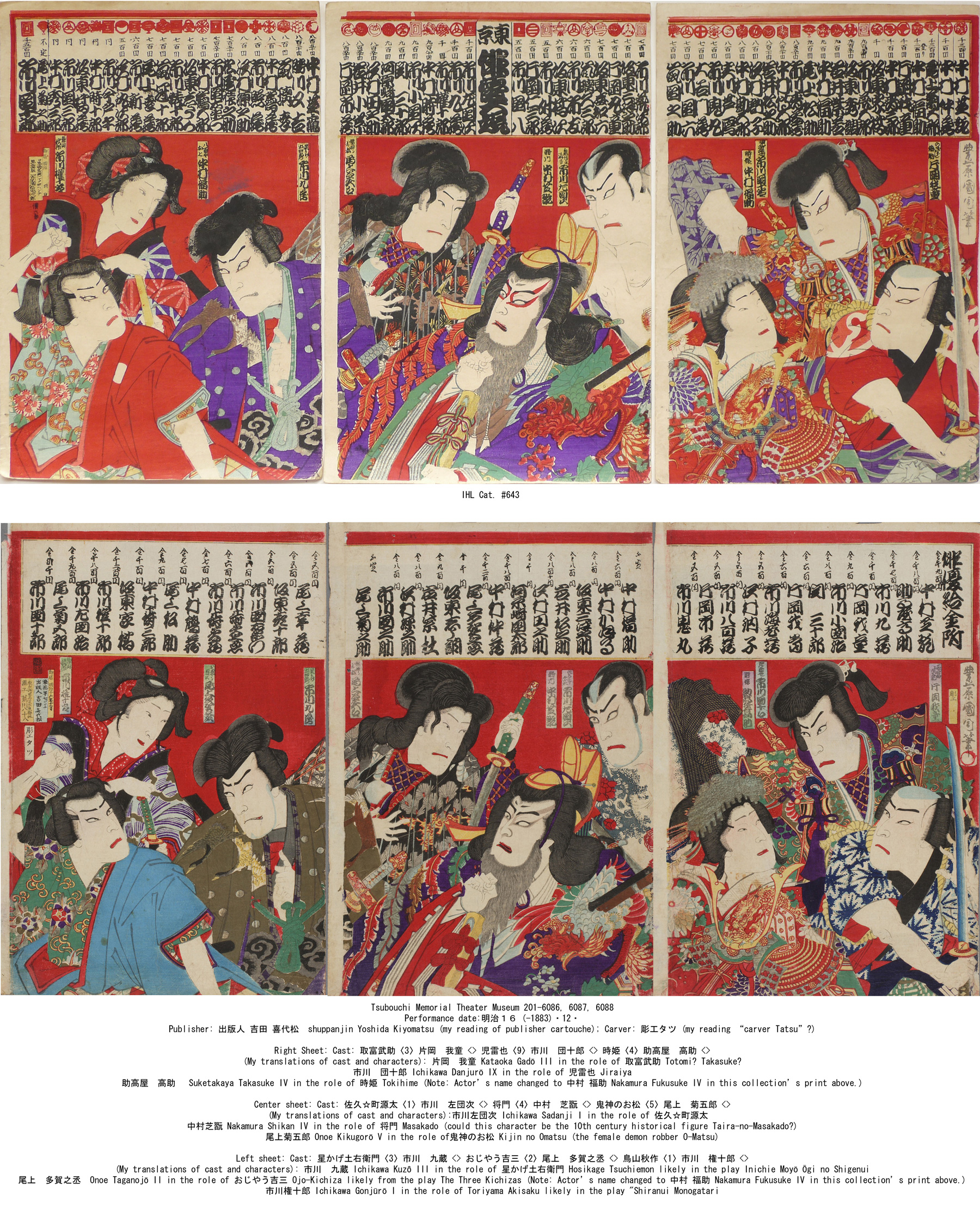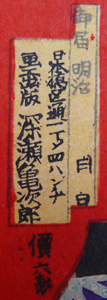About This Print
A depiction of eight different actors in nine roles, along with a listing of their salaries (see below) along with the names and salaries of 56 additional Tokyo-based actors. The actors' identifying crests (mon) are shown above their names. The sloppy production, stray ink marks and poor registration, along with the lack of a date of issue for this print indicate it may have been some type of proof copy. (However, the print does carry a price of six sen below the publisher's seal.) The same blocks used to create the images of the actors on this print were used by a different publisher who changed some of the costumes, changed two of the actors' names pictured and reworked the banner along the top of the print. (See the Tsubouchi image below.)Caught in the Act: Woodblock Kabuki Prints from the Lavenberg Collection of Japanese Prints
July 29 - September 3, 2017 in the Tanabe Gallery at the Portland Japanese Garden

become Tokyo, when Japan was modernizing rapidly. New technology introduced from the West meant the introduction of brilliant colors derived from synthetic dyes that smacked of evolving times. Even so, traditions in kabuki print design remained: details masterfully rendered; cartouches giving the actor's name and role; the action unfolding across multiple sheets of paper.
The Actors Pictured in This Collection's Print
Right panel from right to left (monthly salary listed in top banner):片岡我童 Kataoka Gadō III in the role of 取富武助 Ishidome Busuke - a 1100 yen actor 千百円
市川団十郎 Ichikawa Danjurō IX in the role of 児雷也 Jiraiya - a 1500 yen actor 千五百円
中村 福助 Nakamura Fukusuke IV (also shown in left panel) in the role of 時姫 Tokihime - a 1200 yen actor 千二百円
Center panel from right to left:
市川左団次 Ichikawa Sadanji I in the role of ? (note: the role has been changed from the Tsubouchi database print which shows Sadanji with tattoos) - a 1100 yen 千百円
中村芝翫 Nakamura Shikan IV in the role of 将門 Masakado (could this character be the 10th century historical figure Taira-no-Masakado?) - an 850 yen actor 八百五十円
尾上菊五郎 Onoe Kikugorō V in the role of鬼神のお松 Kijin no Omatsu (the female demon robber O-Matsu) - a 1300 yen actor 千三百円
Left Panel from right to left:
市川九蔵 Ichikawa Kuzô III in the role of 星かげ土右衛門 Hosikage Tsuchiemon likely in the play Inichie Moyō Ōgi no Shigenui - a 1100 yen actor 千百円
中村 福助 Nakamura Fukusuke IV (also shown in right panel) in the role of おじやう吉三 Ojo-Kichiza likely from the play The Three Kichizas - a 1200 yen actor 千二百円
市川権十郎 Ichikawa Gonjūrō I in the role of Toriyama Akisaku likely in the play "Shiranui Monogatari - a 1000 yen actor 千円
For profiles of the actors please see the article The Kabuki Actor.
Actor Crests (Mon)
Despite the poor resolution of a number of the actor crest's along the top of this print, the following crests are easy to discern:  |  |  |  |
Actors' Wages
While there is some English language information available on both pre and post-Meiji salaries for kabuki actors, there seems to be little information available on salaries for Meiji-era kabuki actors. For the salaries shown on the print, my guess is that they are yearly salaries. The highest salary listed is that of Ichikawa Danjurō IX 市川団十郎 at 1,500 yen. As a point of reference, the basic starting pay of a policeman in 1881 was 72 yen per year and for an elementary school teacher in 1886, 60 yen.1In discussing actor salaries at the beginning of the 19th century Arendie and Henk Herwig2 state:
| [T]op actors’ annual earnings were between 1000 and 1500 ryō3. According to Brandon4, 1000 ryō would be the equivalent of 400,000 to 800,000 American dollars today. They did have to pay for their own costly costumes, however. Popular actors received a formal salary, but they were also supported by wealthy patrons who provided extra revenue or paid for expensive costumes. In return, the patrons could expect favours such as the presence of actors at their parties or private performances. It was common practice for actors to honour their patrons with a visit during the first days of the New Year bringing gifts as tokens of gratitude. |
1 "Private Academies of Chinese learning in Meiji Japan: The Decline and Transformation of the Kanguku Juku," Margaret Mehl, Nordic Institute of Asian Studies, 2003, p. xiv.
2 Heroes of the Kabuki Stage: An Introduction to the World of Kabuki with Retellings of Famous Plays, illustrated by Woodblock Prints, Arendie Herwig and Henk J. Herwig, Hotei Publishing, 2004, p. 40.
3 One pre-Meiji ryō was equal to one post-Meiji sen.
4 Kabuki Plays on Stage: Villainy and Vengence, 1773-1799, editors James R. Brandon, Samuel L. Leiter, University of Hawaii Press, 2003, p. 288.
3 One pre-Meiji ryō was equal to one post-Meiji sen.
4 Kabuki Plays on Stage: Villainy and Vengence, 1773-1799, editors James R. Brandon, Samuel L. Leiter, University of Hawaii Press, 2003, p. 288.
Comparison with Tsubouchi Memorial Theatre Museum Print
click on image to enlarge
Print Details
| IHL Catalog | #643 |
| Title (Description) | A Comparison of Actors' Wages (Tokyo) 俳優 見立給金競 (東京) |
| Artist | Toyohara Kunichika (1835–1900) |
| Signature | Toyohara Kunichika hitsu |
| Seal | not sealed |
| Publication Date | not dated (c. 1883) |
| Publisher | Fukase Kamejirō 深瀬亀次郎 (appearing in left rectangular cartouche) with blank publishing date in the rectangular cartouche to its right; showing a price of six sen below the cartouches. [Marks: pub. ref. 068; seal not shown] |
| Carver | not given |
| Impression | fair - many printer's marks, imprecise registration in printing |
| Colors | excellent |
| Condition | good- unbacked; full size, light wrinkling |
| Genre | ukiyo-e; yakusha-e |
| Miscellaneous | |
| Format | vertical oban triptych |
| H x W Paper | 14 3/8 x 9 3/4 in. (36.5 x 24.8 cm) each sheet |
| Literature | |
| Collections This Print | The Tsubouchi Memorial Theatre Museum of Waseda University 201-6086, 201-6087, 201-6088 (a variant of this collection's print); Art Gallery of Greater Victoria 2014.040.011 a-c (a variant of this collection's print) |






